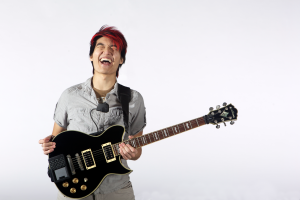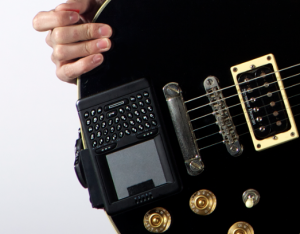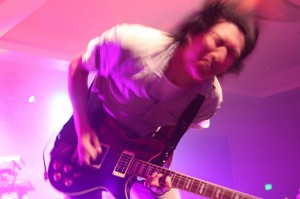
Pinn Panelle’s Derek Song.
A highlight of this year’s NAMM show was hanging out with Derek Song, a 23-year-old digital guitarist whose band, Pinn Panelle, has racked up an astonishing 12.5 million YouTube views with their realtime cover versions of electronic music hits, especially their version of Skrillex’s “Scary Monster and Nice Sprites”
Song, a Berklee College of Music grad, is DIY personified. He’s developed his own innovate guitar controllers and written custom software to milk them to the max. Those hit videos were shot on a shoestring. A Kickstarter campaign financed the Pinn Panelle’s last tour, where they brought live-band energy to DJ-driven EDM concerts and festivals. And the group has created two full albums without help from a label, including the just-released Ghosts and Liars. (However, days before the album’s release, the group’s bassist and keyboardist left the band. Now Derek and drummer Justin Conway are plotting their next moves, though Derek says Pinn Panelle will continue.)
Derek, a blisteringly smart guy with a friendly, unpretentious attitude, was kind enough to let me drag him into a relatively quiet corner of the NAMM show, shove a recorder in his face, and bark questions at him.
But first, that video again:
You’re a music-school dude.
I grew up in Glenview, Illinois, but moved Boston to go to Berklee because I knew I wanted to pursue music and new ideas. When I got there, I figured out that I would waste the least amount of money by pursuing electronic music production rather than performance. I’m not docking performance — some kids get so good at it! But I’ve always been more of a self-learner. I’m a terrible student, especially when I’m given exercises. I just want to play the ideas I have in my mind, and as long as I have the facility to do that, I don’t care about additional technique. But the Electronic Production and Design program at Berkeley had so many cool avenues for exploration, and I knew that technology was the future.
Did you always tinker with tech?
Well, one thing that influenced me as a composer and technologist was the fact that my dad used to fix TVs. Later on, when I started developing my own controllers, I’d work on them with him, and that’s really inspired me musically. When I first started playing in bands, my dad and I invested in a Boss GT-6 multi-effect pedal. I never used stompboxes because I could never afford them! But I read the Boss manual till I knew that thing like the back of my hand, and I still use that GT-6. Basically, I hacked it. I discovered some functions under the surface that open up a lot of opportunities for controlling specific effect parameters.
For example?
Well, the main hack was building controllers that made it do things it wasn’t supposed to do. It’s MIDI-controllable, which means if you send it any kind of MIDI data, even sequencer data, you can make it do crazy stuff. If I want to make an ass-ton of noise, for example, I might send the controller data from my guitar to the delay time, or the ring modulation frequency, or pitch-bending, or the reverb time. That’s how I get a lot of those crazy warping artifacts. You can even get it into realms of granular effect processing. It’s pretty wild! Another technique I use is deliberately screwing up the pitch-tracking by doing things like playing more than one note. When you pair that with ambient effects, you get some really great sounds.
What about that little keyboard controller behind your bridge?

Hint: It’s not for answering email during the drum solo.
That’s my pride and joy, and it’s a bit of a secret. I developed that device so I could finger my guitar while sending off continuous and binary control messages. It’s a wireless QWERTY mini-keyboard with a touchpad mouse that I’ve hacked so it can send continuous controller data. I fun — it’s like having a Korg Kaoss Pad in your guitar. But actually, I don’t use the pad all the much, since I like using my right hand to play guitar. I use the pushbuttons more. The controllers are sending data via Bluetooth, but it’s not as simple as using a Bluetooth mouse. It’s taken me forever to take the right implementation, and it’s just too long-winded and boring to talk about. I don’t have any effect circuitry whatsoever in my guitar, though. The controllers are all I need.
And the guitar?
It’s a Washburn Pro Idol with two humbuckers that I originally won in a high school competition. The pickup coils are splittable, so I can get a the single-coil sound I like for clean tones.
Amp?
A Hughes & Kettner Switchblade, which is a tube amp that lets you change gain stages via MIDI. I have effects before and after the preamp. Maybe one day I’ll have a giant refrigerator rack full of awesome stompboxes. [Laughs.] But if I had that much money, I could just hire people to turn knobs for me.
Where you a punk kid or a metal kid?
I started out listening to my dad’s old records — stuff like the Beatles. Then I got into Metallica and punk stuff like Blink 182. Then I became a bit of a rock guitar elitist and got into Dream Theater and Rush. But once I got into Berklee, I opened myself to all sorts of stuff. But at the same time I realized that I was never going to catch up with some of the other students on a technical level, and I felt I had more important things to contribute as a songwriter and lyricist. Electronic music opened many doors too, in terms of sound design and production.
What does the band’s name mean?
It’s from the words “pin panel” on a pachinko machine. It’s inspired by a Teenage Mutant Ninja Turtles game my brothers and I used to play at Chuck E. Cheese.
Do you perform to a click?
We do play to click, though Justin, our drummer, is the only one who hears it. But we’re very adamant about not using any backing tracks while we play. Our drummer and keyboardist constantly trigger samples. A lot of their parts are structured like a bass drum line in a marching band, where they trade off single notes to create melodic lines.
Is realtime electronica your main musical focus?
That’s a great question. We did those cover tunes strictly for the sake of experimentation, but we really are very inspired by new producers who push things in new directions. The first time I heard grime and Skillex, I couldn’t believe that a computer was making such organic sounds. It was so cool and rich! I thought, holy crap, we have to do this in a live performance situation. On our first album, we were very much a rock band with electronics in the background. I was a big fan of more experimental bands like Mute Math and Muse. But when I got more into electronic music, I got excited by its new song-form ideas.
On the other hand, it’s always a challenge to incorporate technology without doing it for the sake of technology. A lot of the appeal of our Skrillex video is in its shock value. Now, schlock value is a great tool — look how Lady Gaga uses it! But it’s not ultimately the source of true art. We’ve done a lot EDM of shows where we’re literally onstage between two DJs. Now, don’t get me wrong — I love playing those shows, and I love the energy from the crowd. But I do feel there’s a lack of lyrical and songwriting depth to that genre, and at the end of the day, it really is all about the songs.
Tell me about your stage rig.
It’s been such a long-term experiment! I’m always trying to come up with a more reliable system. Essentially, I’m running a very heavily modified prototype. I’ve had to search a long time to find anything close to road-ready. Also I have to come up with ways to make sure my stuff runs every night, which means things like disguising myself as a roadie and running through diagnostics right before we go onstage. Anyway, I use a Line 6 Relay wireless in a rack next to my pedalboard, which has a spot for my laptop, where I processes all the data from my controllers. I don’t want to say the exact program it’s running, but I can say that it’s affordable stuff that anyone can get and use. And all I can say is: “Listen kids: Learn your Max/MSP!”
Sorry for being pushy, but — in other words, you build your processers using Max?
[Pauses.] Yeah. I also like Junction a lot.

Are you signed? Do you even want to be signed?
That’s something I’m still working through as an artist. I don’t think we’ve completely discovered our “real” community yet, and we’re still discovering our sound. We’re releasing our second album on our own, though we’re talking to labels. We’d definitely like to get on a good tour.
Look, I want to write music that communicates to people. I don’t mind a mass audience, as long as it’s my mass audience. We’ve done such cool stuff on our own with our YouTube presence, but in the end, I would like to be part of a team of likeminded people who love the music and want to help create a great show and a great experience and a great community. If a record label can help me get there, then I definitely want to talk to them!
We have had the opportunity to work with Tom Jackson, the live music producer for Taylor Swift. He tries to help up communicate properly and clearly to an audience. For example, you’ll notice that all my controllers are about allowing me to be away from my pedalboard and nearer the crowd. He taught me not only to have more authority on stage, but to communicate more and have a more diverse and fun show. I can tell you this much: If you come to our live show, you will a) see us move, and b) see those movements correspond to what you hear. It will be about communication. [Laughs.] It will be a goddamn performance!








Joe, you are always turning us onto new cool music! The might have had 12 million views, but I’ve never heard them before!
In full agreement….not on my radar…Thank you Joe expanding my mind.
very cool!! Can we add him to the panel of our digital guitar advisory board?
Was smiling all the time and thought that Bach music was the pinnacle, since that time all simply goes downward.